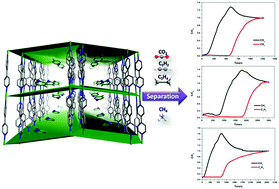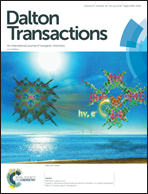Enhanced gas separation performance of an ultramicroporous pillared-layer framework induced by hanging bare Lewis basic pyridine groups†
Abstract
Pillared-layer metal–organic frameworks show great promise for gas storage and separation because their pore size as well as functionality usually can be controlled and adjusted synergistically. By combining the common pyridine and carboxylate groups, we design herein a new 3D pillared-layer framework, [Co2(DBPT)(BPY)2(CO3)]n (SNNU-95). Dinuclear [Co2] motifs are connected by DBPT ligands to form a 2D layer, which is further bridged by BPY to obtain the 3D pillar-layered framework of SNNU-95. Remarkably, two un-coordinated pyridine groups of DBPT not only help stabilize the 2D layer through π⋯π stacking but also point into the 1D channels to create an ultramicroporous environment. Taking advantage of the ultramicroporosity and pyridine Lewis basic sites, SNNU-95 shows not only extra high CO2 over CH4 and C2 hydrocarbons over CH4 selectivity, but also remarkable C2H2/CO2, C2H2/C2H4, and C2H4/CO2 separation under ambient conditions. This synergistic effect resulting from functional groups and pore size provides a promising route to design porous materials for the highest possible gas uptake and separation performance.



 Please wait while we load your content...
Please wait while we load your content...